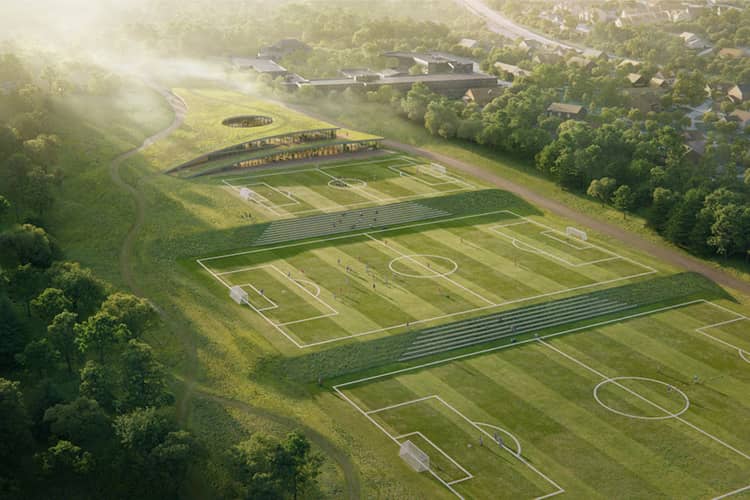Snøhetta, the internationally acclaimed architecture firm, has once again demonstrated its ability to seamlessly blend tradition with modernity through its latest proposals for the Norwegian National Football Team’s training facilities. With designs intended for Asker and Ski, two cities just outside Oslo, Snøhetta has envisioned state-of-the-art sports complexes that pay homage to Norway’s rich Nordic architectural heritage while incorporating cutting-edge sustainability features.
Drawing inspiration from Norwegian Long Houses, these structures are not merely training centers—they are architectural masterpieces that integrate harmoniously with the surrounding landscapes. Through their innovative use of renewable materials, organic forms, and energy-efficient technology, these facilities promise to set a new benchmark for sustainable sports infrastructure.
This article explores Snøhetta’s groundbreaking designs, delving into the architectural elements, ecological principles, and broader impact these facilities will have on Norwegian football and the local community.
A Nod to Norway’s Architectural Heritage
Snøhetta is known for its ability to weave cultural history into contemporary architecture, and this project is no exception. The training facilities take direct inspiration from Norway’s traditional Long Houses, elongated structures that have historically served as communal gathering spaces. These ancient forms have been reinterpreted through a modern lens, creating facilities that feel both rooted in tradition and forward-thinking.
One of the most striking aspects of the designs is the curved forms of the buildings. Rather than imposing sharp, artificial lines, Snøhetta has chosen soft, undulating shapes that blend effortlessly with the natural terrain. The rooftops, partially covered in greenery, allow the structures to meld into the surrounding landscapes, creating a harmonious balance between the built environment and nature.
At the heart of the Asker facility is a central courtyard, framed by a circular roof opening that floods the interior spaces with natural light. This design choice not only enhances energy efficiency but also fosters a sense of openness and connection to the outdoors. The courtyard serves as a gathering space, further emphasizing the communal spirit deeply embedded in Norway’s cultural and architectural traditions.
Innovative and Functional Design Features
One of the most defining elements of Snøhetta’s designs is the terraced landscape, which extends beyond mere aesthetics to serve functional purposes. Instead of traditional bleachers, elongated steps gracefully cascade down toward the training fields, creating natural seating areas for spectators. This approach seamlessly integrates the spectator experience into the architectural vision, eliminating the need for separate, bulky seating structures.
This tiered landscape provides multiple vantage points, ensuring that fans, coaches, and players can all engage with the games in an immersive environment. The terraces also allow for smooth transitions between indoor and outdoor spaces, reinforcing Snøhetta’s philosophy of designing fluid, interconnected spaces.
Sustainability at the Core
Snøhetta’s training facilities are designed with sustainability as a guiding principle, ensuring that these spaces minimize their environmental footprint while maximizing efficiency. The firm has incorporated the following eco-friendly elements:
• Cross-Laminated Timber (CLT) Construction: The buildings are constructed using renewable CLT wood, a material known for its strength, durability, and environmental benefits. This choice not only reduces carbon emissions but also gives the structures a warm, natural aesthetic that resonates with the surrounding landscape.
• Solar Panel Integration: The rooftops feature extensive solar panels, generating renewable energy to power the training facilities. This ensures that the structures are not reliant on non-renewable energy sources, significantly reducing their environmental impact.
• Green Roofs for Insulation and Biodiversity: Portions of the rooftops are covered with vegetation, providing natural insulation while promoting local biodiversity. These green roofs help regulate indoor temperatures, reducing the need for artificial heating and cooling.
• Natural Light Optimization: The central courtyard and expansive windows ensure that indoor spaces receive ample natural light, reducing the reliance on artificial lighting and enhancing energy efficiency.
These design choices place the Norwegian National Football Team’s training centers at the forefront of sustainable architecture, setting a precedent for future sports infrastructure projects worldwide.
Beyond Football: A Hub for Sports and Education
While the primary purpose of these facilities is to serve as elite training centers for Norway’s national team, Snøhetta’s vision extends far beyond football. The designs also include administrative offices, a sports high school, and external offices for the Norwegian Football Association, making these facilities vital community hubs.
A Dedicated Space for the Next Generation of Athletes
The sports high school integrated into the facilities underscores Norway’s commitment to developing young talent. Students will have access to world-class training grounds, modern classrooms, and sports science labs, ensuring that academics and athletics go hand in hand.
By bringing together students, coaches, and professional players under one roof, the training centers will foster an environment of mentorship and inspiration, allowing young athletes to learn from the very best. This approach not only benefits Norwegian football but also strengthens the country’s sporting infrastructure as a whole.
Strengthening Community Engagement
Snøhetta’s designs emphasize public accessibility, ensuring that the training centers do not function as isolated facilities for the national team alone. Local football clubs, aspiring athletes, and sports organizations will also have the opportunity to utilize the world-class facilities, reinforcing the notion that these spaces are designed to benefit both professionals and grassroots-level players.
Furthermore, the inclusion of administrative offices for the Norwegian Football Association ensures that these training centers serve as the official nerve center for football development programs, strategic planning, and talent scouting.
A Landmark in the Making: Anticipation and Future Impact
Although an official completion date has yet to be announced, Snøhetta’s proposals have already generated significant excitement within the architectural and sports communities. The designs represent a bold step toward the future, proving that high-performance sports facilities can be both sustainable and visually stunning.
Setting a Global Precedent
The Norwegian National Football Team’s new training facilities will undoubtedly serve as an international benchmark for sports infrastructure. The seamless integration of eco-conscious materials, innovative design principles, and functional aesthetics demonstrates how architecture can enhance performance while minimizing environmental impact.
As global concerns surrounding climate change intensify, projects like these will serve as a model for future stadiums, arenas, and training grounds, proving that sustainability and world-class sports facilities are not mutually exclusive.
An Iconic Addition to Norway’s Architectural Landscape
Beyond their functional significance, these training centers are poised to become iconic landmarks in the cities of Asker and Ski. Their graceful forms, strategic placement within the landscape, and homage to traditional Nordic architecture will ensure that they stand as symbols of Norwegian pride.
In years to come, these facilities will likely be more than just training grounds—they will be architectural attractions, drawing visitors interested in both football and design.
The Future of Sports Architecture
Snøhetta’s proposed designs for Norway’s National Football Team’s training facilities embody the perfect fusion of tradition, innovation, and sustainability. With their deep respect for Norway’s architectural heritage and forward-thinking approach to sports infrastructure, these spaces will undoubtedly shape the future of Norwegian football while redefining the role of training centers in modern society.
By embracing renewable materials, energy-efficient technology, and community-focused spaces, Snøhetta has set a new gold standard for sustainable sports architecture. As the world eagerly awaits the completion of these remarkable structures, one thing is clear: Norway is about to redefine what it means to train, compete, and excel in the realm of international football.
No comments yet.








